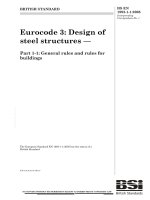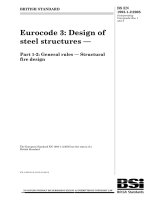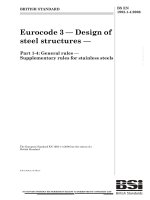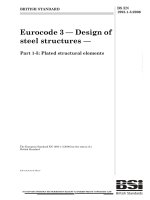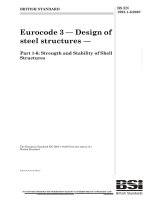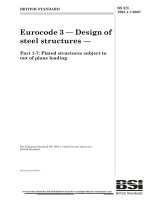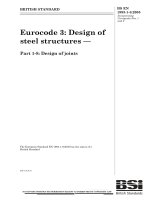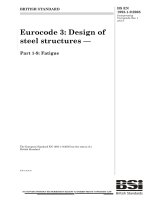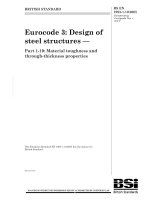Tiêu chuẩn Châu Âu EC8: Kết cấu chống động đất phần 1: Quy định chung (Eurocode8 BS EN1998 1 e 2004 Design of structure for earthquake resistance part 1: General rules, seismic actions and rules for buildings)
Bạn đang xem bản rút gọn của tài liệu. Xem và tải ngay bản đầy đủ của tài liệu tại đây (2.42 MB, 232 trang )
BS EN
1998-1:2004
BRITISH STANDARD
Eurocode 8: Design of
structures for
earthquake
resistance —
Part 1: General rules, seismic actions
and rules for buildings
The European Standard EN 1998-1:2004 has the status of a
British Standard
ICS 91.120.25
--`,`,,,`,``,,,```````,,`,,`,,-`-`,,`,,`,`,,`---
12 &23<,1* :,7+287 %6, 3(50,66,21 (;&(37 $6 3(50,77(' %< &23<5,*+7 /$:
Copyright European Committee for Standardization
Provided by IHS under license with CEN
No reproduction or networking permitted without license from IHS
Licensee=Politecnico Milano/5935522004
Not for Resale, 03/13/2006 07:13:43 MST
BS EN 1998-1:2004
National foreword
This British Standard is the official English language version of EN 1998-1:2004. It
supersedes DD ENV 1998-1-1:1996, DD ENV 1998-1-2:1996 and
DD ENV 1998-1-3:1996 which are withdrawn.
--`,`,,,`,``,,,```````,,`,,`,,-`-`,,`,,`,`,,`---
The structural Eurocodes are divided into packages by grouping Eurocodes for each of
the main materials, concrete, steel, composite concrete and steel, timber, masonry and
aluminium. This is to enable a common date of withdrawal (DOW) for all the relevant
parts that are needed for a particular design. The conflicting national standards will be
withdrawn at the end of the coexistence period, after all the EN Eurocodes of a package
are available.
Following publication of the EN, there is a period of 2 years allowed for the national
calibration period during which the national annex is issued, followed by a three year
coexistence period. During the coexistence period Member States will be encouraged to
adapt their national provisions to withdraw conflicting national rules before the end of
the coexistent period. The Commission in consultation with Member States is expected
to agree the end of the coexistence period for each package of Eurocodes.
The UK participation in its preparation was entrusted by Technical Committee B/525,
Building and civil engineering structures, to Subcommittee B/525/8, Structures in
seismic regions, which has the responsibility to:
—
aid enquirers to understand the text;
—
present to the responsible international/European committee any enquiries
on the interpretation, or proposals for change, and keep the UK interests
informed;
monitor related international and European developments and promulgate
them in the UK.
—
A list of organizations represented on this subcommittee can be obtained on request to
its secretary.
Where a normative part of this EN allows for a choice to be made at the national level,
the range and possible choice will be given in the normative text, and a note will qualify
it as a Nationally Determined Parameter (NDP). NDPs can be specific value for a factor,
a specific level or class, a particular method or a particular application rule if several
are proposed in the EN.
To enable EN 1998 to be used in the UK, the NDPs will be published in a National
Annex, which will be made available by BSI in due course, after public consultation has
taken place.
There are generally no requirements in the UK to consider seismic loading, and the
whole of the UK may be considered an area of very low seismicity in which the
provisions of EN 1998 need not apply. However, certain types of structure, by reason of
their function, location or form, may warrant an explicit consideration of seismic
actions. It is the intention in due course to publish separately background information
on the circumstances in which this might apply in the UK.
This British Standard was
published under the authority
of the Standards Policy and
Strategy Committee on
8 April 2005
Cross-references
The British Standards which implement international or European publications
referred to in this document may be found in the BSI Catalogue under the section
entitled “International Standards Correspondence Index”, or by using the “Search”
facility of the BSI Electronic Catalogue or of British Standards Online.
This publication does not purport to include all the necessary provisions of a contract.
Users are responsible for its correct application.
Compliance with a British Standard does not of itself confer immunity from
legal obligations.
Summary of pages
This document comprises a front cover, an inside front cover, the EN title page, pages 2
to 229 and a back cover.
The BSI copyright notice displayed in this document indicates when the document was
last issued.
© BSI 8 April 2005
Amendments issued since publication
Amd. No.
Date
Comments
ISBN 0 580 45872 5
Copyright European Committee for Standardization
Provided by IHS under license with CEN
No reproduction or networking permitted without license from IHS
Licensee=Politecnico Milano/5935522004
Not for Resale, 03/13/2006 07:13:43 MST
EUROPEAN STANDARD
EN 1998-1
NORME EUROPÉENNE
EUROPÄISCHE NORM
December 2004
ICS 91.120.25
Supersedes ENV 1998-1-1:1994, ENV 1998-1-2:1994,
ENV 1998-1-3:1995
English version
Eurocode 8: Design of structures for earthquake resistance Part 1: General rules, seismic actions and rules for buildings
Eurocode 8: Calcul des structures pour leur résistance aux
séismes - Partie 1: Règles générales, actions sismiques et
règles pour les bâtiments
Eurocode 8: Auslegung von Bauwerken gegen Erdbeben Teil 1: Grundlagen, Erdbebeneinwirkungen und Regeln für
Hochbauten
This European Standard was approved by CEN on 23 April 2004.
CEN members are bound to comply with the CEN/CENELEC Internal Regulations which stipulate the conditions for giving this European
Standard the status of a national standard without any alteration. Up-to-date lists and bibliographical references concerning such national
standards may be obtained on application to the Central Secretariat or to any CEN member.
--`,`,,,`,``,,,```````,,`,,`,,-`-`,,`,,`,`,,`---
This European Standard exists in three official versions (English, French, German). A version in any other language made by translation
under the responsibility of a CEN member into its own language and notified to the Central Secretariat has the same status as the official
versions.
CEN members are the national standards bodies of Austria, Belgium, Cyprus, Czech Republic, Denmark, Estonia, Finland, France,
Germany, Greece, Hungary, Iceland, Ireland, Italy, Latvia, Lithuania, Luxembourg, Malta, Netherlands, Norway, Poland, Portugal, Slovakia,
Slovenia, Spain, Sweden, Switzerland and United Kingdom.
EUROPEAN COMMITTEE FOR STANDARDIZATION
COMITÉ EUROPÉEN DE NORMALISATION
EUROPÄISCHES KOMITEE FÜR NORMUNG
Management Centre: rue de Stassart, 36
© 2004 CEN
B-1050 Brussels
All rights of exploitation in any form and by any means reserved
worldwide for CEN national Members.
Copyright European Committee for Standardization
Provided by IHS under license with CEN
No reproduction or networking permitted without license from IHS
Licensee=Politecnico Milano/5935522004
Not for Resale, 03/13/2006 07:13:43 MST
Ref. No. EN 1998-1:2004: E
EN 1998-1:2004 (E)
Contents
Page
FOREWORD ..............................................................................................................................................8
1
GENERAL.......................................................................................................................................15
1.1
1.1.1
1.1.2
1.1.3
1.2
1.2.1
1.2.2
1.3
1.4
1.5
1.5.1
1.5.2
1.6
1.6.1
1.6.2
1.6.3
1.6.4
1.6.5
1.6.6
1.6.7
1.6.8
1.6.9
1.7
2
SCOPE ......................................................................................................................................15
Scope of EN 1998...............................................................................................................15
Scope of EN 1998-1 ...........................................................................................................15
Further Parts of EN 1998....................................................................................................16
NORMATIVE REFERENCES ........................................................................................................16
General reference standards................................................................................................16
Reference Codes and Standards..........................................................................................17
ASSUMPTIONS ..........................................................................................................................17
DISTINCTION BETWEEN PRINCIPLES AND APPLICATION RULES .................................................17
TERMS AND DEFINITIONS .........................................................................................................17
Terms common to all Eurocodes ........................................................................................17
Further terms used in EN 1998...........................................................................................17
SYMBOLS .................................................................................................................................19
General ...............................................................................................................................19
Further symbols used in Sections 2 and 3 of EN 1998-1....................................................19
Further symbols used in Section 4 of EN 1998-1 ...............................................................20
Further symbols used in Section 5 of EN 1998-1 ...............................................................21
Further symbols used in Section 6 of EN 1998-1 ...............................................................24
Further symbols used in Section 7 of EN 1998-1 ...............................................................25
Further symbols used in Section 8 of EN 1998-1 ...............................................................27
Further symbols used in Section 9 of EN 1998-1 ...............................................................27
Further symbols used in Section 10 of EN 1998-1 .............................................................28
S.I. UNITS ................................................................................................................................28
PERFORMANCE REQUIREMENTS AND COMPLIANCE CRITERIA ..............................29
2.1
FUNDAMENTAL REQUIREMENTS ...............................................................................................29
2.2
COMPLIANCE CRITERIA............................................................................................................30
2.2.1
General ...............................................................................................................................30
2.2.2
Ultimate limit state .............................................................................................................30
2.2.3
Damage limitation state ......................................................................................................31
2.2.4
Specific measures ...............................................................................................................32
2.2.4.1
2.2.4.2
2.2.4.3
3
Design ..................................................................................................................................... 32
Foundations............................................................................................................................. 32
Quality system plan................................................................................................................. 32
GROUND CONDITIONS AND SEISMIC ACTION..................................................................33
3.2.2.1
3.2.2.2
3.2.2.3
3.2.2.4
3.2.2.5
3.2.3
Alternative representations of the seismic action ...............................................................42
3.2.3.1
3.2.3.2
3.2.4
4
General.................................................................................................................................... 36
Horizontal elastic response spectrum ...................................................................................... 37
Vertical elastic response spectrum .......................................................................................... 40
Design ground displacement ................................................................................................... 41
Design spectrum for elastic analysis ....................................................................................... 41
Time - history representation .................................................................................................. 42
Spatial model of the seismic action ......................................................................................... 43
Combinations of the seismic action with other actions.......................................................44
DESIGN OF BUILDINGS .............................................................................................................45
4.1
GENERAL .................................................................................................................................45
2
Copyright European Committee for Standardization
Provided by IHS under license with CEN
No reproduction or networking permitted without license from IHS
Licensee=Politecnico Milano/5935522004
Not for Resale, 03/13/2006 07:13:43 MST
--`,`,,,`,``,,,```````,,`,,`,,-`-`,,`,,`,`,,`---
3.1
GROUND CONDITIONS ..............................................................................................................33
3.1.2
Identification of ground types.............................................................................................33
3.2
SEISMIC ACTION .......................................................................................................................35
3.2.1
Seismic zones .....................................................................................................................35
3.2.2
Basic representation of the seismic action ..........................................................................36
EN 1998-1:2004 (E)
4.1.1
Scope ..................................................................................................................................45
4.2
CHARACTERISTICS OF EARTHQUAKE RESISTANT BUILDINGS ....................................................45
4.2.1
Basic principles of conceptual design.................................................................................45
4.2.1.1
4.2.1.2
4.2.1.3
4.2.1.4
4.2.1.5
4.2.1.6
4.2.2
4.2.3
Structural simplicity ................................................................................................................ 45
Uniformity, symmetry and redundancy................................................................................... 45
Bi-directional resistance and stiffness ..................................................................................... 46
Torsional resistance and stiffness............................................................................................ 46
Diaphragmatic behaviour at storey level ................................................................................. 46
Adequate foundation ............................................................................................................... 47
Primary and secondary seismic members ...........................................................................47
Criteria for structural regularity..........................................................................................48
4.2.3.1
4.2.3.2
4.2.3.3
General.................................................................................................................................... 48
Criteria for regularity in plan................................................................................................... 49
Criteria for regularity in elevation........................................................................................... 50
4.2.4
Combination coefficients for variable actions ....................................................................52
4.2.5
Importance classes and importance factors ........................................................................52
4.3
STRUCTURAL ANALYSIS ...........................................................................................................53
4.3.1
Modelling ...........................................................................................................................53
4.3.2
Accidental torsional effects ................................................................................................54
4.3.3
Methods of analysis ............................................................................................................54
4.3.3.1
4.3.3.2
4.3.3.3
4.3.3.4
4.3.3.5
4.3.4
4.3.5
Displacement calculation....................................................................................................66
Non-structural elements......................................................................................................66
4.3.5.1
4.3.5.2
4.3.5.3
4.3.5.4
4.3.6
General.................................................................................................................................... 54
Lateral force method of analysis ............................................................................................. 56
Modal response spectrum analysis .......................................................................................... 59
Non-linear methods................................................................................................................. 61
Combination of the effects of the components of the seismic action ...................................... 64
General.................................................................................................................................... 66
Verification ............................................................................................................................. 67
Importance factors................................................................................................................... 68
Behaviour factors .................................................................................................................... 68
Additional measures for masonry infilled frames...............................................................68
4.3.6.1
4.3.6.2
4.3.6.3
4.3.6.4
General.................................................................................................................................... 68
Requirements and criteria........................................................................................................ 69
Irregularities due to masonry infills ........................................................................................ 69
Damage limitation of infills .................................................................................................... 70
4.4
SAFETY VERIFICATIONS ...........................................................................................................71
4.4.1
General ...............................................................................................................................71
4.4.2
Ultimate limit state .............................................................................................................71
4.4.2.1
4.4.2.2
4.4.2.3
4.4.2.4
4.4.2.5
4.4.2.6
4.4.2.7
Damage limitation ..............................................................................................................76
4.4.3.1
4.4.3.2
5
General.................................................................................................................................... 76
Limitation of interstorey drift.................................................................................................. 76
SPECIFIC RULES FOR CONCRETE BUILDINGS .................................................................78
5.1
GENERAL .................................................................................................................................78
5.1.1
Scope ..................................................................................................................................78
5.1.2
Terms and definitions .........................................................................................................78
5.2
DESIGN CONCEPTS ...................................................................................................................80
5.2.1
Energy dissipation capacity and ductility classes ...............................................................80
5.2.2
Structural types and behaviour factors................................................................................81
5.2.2.1
5.2.2.2
5.2.3
Structural types ....................................................................................................................... 81
Behaviour factors for horizontal seismic actions..................................................................... 82
Design criteria ....................................................................................................................84
5.2.3.1
5.2.3.2
5.2.3.3
5.2.3.4
General.................................................................................................................................... 84
Local resistance condition....................................................................................................... 84
Capacity design rule................................................................................................................ 84
Local ductility condition ......................................................................................................... 84
3
Copyright European Committee for Standardization
Provided by IHS under license with CEN
No reproduction or networking permitted without license from IHS
Licensee=Politecnico Milano/5935522004
Not for Resale, 03/13/2006 07:13:43 MST
--`,`,,,`,``,,,```````,,`,,`,,-`-`,,`,,`,`,,`---
4.4.3
General.................................................................................................................................... 71
Resistance condition................................................................................................................ 71
Global and local ductility condition ........................................................................................ 72
Equilibrium condition ............................................................................................................. 74
Resistance of horizontal diaphragms....................................................................................... 74
Resistance of foundations........................................................................................................ 74
Seismic joint condition............................................................................................................ 75
EN 1998-1:2004 (E)
5.2.3.5
5.2.3.6
5.2.3.7
Structural redundancy ............................................................................................................. 86
Secondary seismic members and resistances........................................................................... 86
Specific additional measures ................................................................................................... 86
5.2.4
Safety verifications .............................................................................................................87
5.3
DESIGN TO EN 1992-1-1 ..........................................................................................................87
5.3.1
General ...............................................................................................................................87
5.3.2
Materials .............................................................................................................................88
5.3.3
Behaviour factor .................................................................................................................88
5.4
DESIGN FOR DCM....................................................................................................................88
5.4.1
Geometrical constraints and materials................................................................................88
5.4.1.1
5.4.1.2
5.4.2
Design action effects ..........................................................................................................89
5.4.2.1
5.4.2.2
5.4.2.3
5.4.2.4
5.4.2.5
5.4.3
Material requirements ............................................................................................................. 88
Geometrical constraints........................................................................................................... 88
General.................................................................................................................................... 89
Beams...................................................................................................................................... 89
Columns .................................................................................................................................. 91
Special provisions for ductile walls......................................................................................... 92
Special provisions for large lightly reinforced walls ............................................................... 94
ULS verifications and detailing ..........................................................................................95
5.4.3.1
5.4.3.2
5.4.3.3
5.4.3.4
5.4.3.5
Beams...................................................................................................................................... 95
Columns .................................................................................................................................. 97
Beam-column joints .............................................................................................................. 100
Ductile Walls......................................................................................................................... 100
Large lightly reinforced walls ............................................................................................... 104
5.5
DESIGN FOR DCH ..................................................................................................................106
5.5.1
Geometrical constraints and materials..............................................................................106
5.5.1.1
5.5.1.2
5.5.2
Design action effects ........................................................................................................107
5.5.2.1
5.5.2.2
5.5.2.3
5.5.2.4
5.5.3
Material requirements ........................................................................................................... 106
Geometrical constraints......................................................................................................... 106
Beams.................................................................................................................................... 107
Columns ................................................................................................................................ 107
Beam-column joints .............................................................................................................. 107
Ductile Walls......................................................................................................................... 108
ULS verifications and detailing ........................................................................................109
5.5.3.1
5.5.3.2
5.5.3.3
5.5.3.4
5.5.3.5
Beams.................................................................................................................................... 109
Columns ................................................................................................................................ 111
Beam-column joints .............................................................................................................. 112
Ductile Walls......................................................................................................................... 114
Coupling elements of coupled walls...................................................................................... 119
5.6
PROVISIONS FOR ANCHORAGES AND SPLICES .........................................................................120
5.6.1
General .............................................................................................................................120
5.6.2
Anchorage of reinforcement .............................................................................................120
5.6.2.1
5.6.2.2
Columns ................................................................................................................................ 120
Beams.................................................................................................................................... 120
5.6.3
Splicing of bars.................................................................................................................122
5.7
DESIGN AND DETAILING OF SECONDARY SEISMIC ELEMENTS .................................................123
5.8
CONCRETE FOUNDATION ELEMENTS ......................................................................................123
5.8.1
Scope ................................................................................................................................123
5.8.2
Tie-beams and foundation beams .....................................................................................124
5.8.3
Connections of vertical elements with foundation beams or walls...................................125
5.8.4
Cast-in-place concrete piles and pile caps ........................................................................125
5.9
LOCAL EFFECTS DUE TO MASONRY OR CONCRETE INFILLS .....................................................126
5.10
PROVISIONS FOR CONCRETE DIAPHRAGMS .............................................................................127
5.11
PRECAST CONCRETE STRUCTURES ..........................................................................................127
5.11.1
General.........................................................................................................................127
5.11.1.1
5.11.1.2
5.11.1.3
5.11.1.4
5.11.1.5
5.11.2
5.11.2.1
5.11.2.2
5.11.3
4
Copyright European Committee for Standardization
Provided by IHS under license with CEN
No reproduction or networking permitted without license from IHS
Scope and structural types..................................................................................................... 127
Evaluation of precast structures ............................................................................................ 128
Design criteria ....................................................................................................................... 129
Behaviour factors .................................................................................................................. 130
Analysis of transient situation ............................................................................................... 130
Connections of precast elements..................................................................................131
General provisions ................................................................................................................ 131
Evaluation of the resistance of connections........................................................................... 132
Elements ......................................................................................................................132
--`,`,,,`,``,,,```````,,`,,`,,-`-`,,`,,`,`,,`---
Licensee=Politecnico Milano/5935522004
Not for Resale, 03/13/2006 07:13:43 MST
EN 1998-1:2004 (E)
5.11.3.1
5.11.3.2
5.11.3.3
5.11.3.4
5.11.3.5
6
Beams.................................................................................................................................... 132
Columns ................................................................................................................................ 132
Beam-column joints .............................................................................................................. 133
Precast large-panel walls....................................................................................................... 133
Diaphragms ........................................................................................................................... 135
SPECIFIC RULES FOR STEEL BUILDINGS .........................................................................137
6.1
6.1.1
6.1.2
6.1.3
6.2
6.3
6.3.1
6.3.2
6.4
6.5
GENERAL ...............................................................................................................................137
Scope ................................................................................................................................137
Design concepts................................................................................................................137
Safety verifications ...........................................................................................................138
MATERIALS ............................................................................................................................138
STRUCTURAL TYPES AND BEHAVIOUR FACTORS .....................................................................140
Structural types .................................................................................................................140
Behaviour factors..............................................................................................................143
STRUCTURAL ANALYSIS .........................................................................................................144
DESIGN CRITERIA AND DETAILING RULES FOR DISSIPATIVE STRUCTURAL BEHAVIOUR COMMON
TO ALL STRUCTURAL TYPES ..................................................................................................................144
6.5.1
General .............................................................................................................................144
6.5.2
Design criteria for dissipative structures ..........................................................................144
6.5.3
Design rules for dissipative elements in compression or bending ....................................145
6.5.4
Design rules for parts or elements in tension....................................................................145
6.5.5
Design rules for connections in dissipative zones ............................................................145
6.6
DESIGN AND DETAILING RULES FOR MOMENT RESISTING FRAMES ..........................................146
6.6.1
Design criteria ..................................................................................................................146
6.6.2
Beams ...............................................................................................................................146
6.6.3
Columns............................................................................................................................147
6.6.4
Beam to column connections............................................................................................149
6.7
DESIGN AND DETAILING RULES FOR FRAMES WITH CONCENTRIC BRACINGS ...........................150
6.7.1
Design criteria ..................................................................................................................150
6.7.2
Analysis ............................................................................................................................151
6.7.3
Diagonal members............................................................................................................152
6.7.4
Beams and columns ..........................................................................................................152
6.8
DESIGN AND DETAILING RULES FOR FRAMES WITH ECCENTRIC BRACINGS .............................153
6.8.1
Design criteria ..................................................................................................................153
6.8.2
Seismic links.....................................................................................................................154
6.8.3
Members not containing seismic links..............................................................................157
6.8.4
Connections of the seismic links ......................................................................................158
6.9
DESIGN RULES FOR INVERTED PENDULUM STRUCTURES ........................................................158
6.10
DESIGN RULES FOR STEEL STRUCTURES WITH CONCRETE CORES OR CONCRETE WALLS AND FOR
MOMENT RESISTING FRAMES COMBINED WITH CONCENTRIC BRACINGS OR INFILLS ..............................159
6.10.1
Structures with concrete cores or concrete walls .........................................................159
6.10.2
Moment resisting frames combined with concentric bracings.....................................159
6.10.3
Moment resisting frames combined with infills...........................................................159
6.11
CONTROL OF DESIGN AND CONSTRUCTION .............................................................................159
SPECIFIC RULES FOR COMPOSITE STEEL – CONCRETE BUILDINGS .....................161
7.1
7.1.1
7.1.2
7.1.3
7.2
7.2.1
7.2.2
7.2.3
7.3
7.3.1
7.3.2
7.4
7.4.1
7.4.2
GENERAL ...............................................................................................................................161
Scope ................................................................................................................................161
Design concepts................................................................................................................161
Safety verifications ...........................................................................................................162
MATERIALS ............................................................................................................................163
Concrete............................................................................................................................163
Reinforcing steel...............................................................................................................163
Structural steel ..................................................................................................................163
STRUCTURAL TYPES AND BEHAVIOUR FACTORS .....................................................................163
Structural types .................................................................................................................163
Behaviour factors..............................................................................................................165
STRUCTURAL ANALYSIS .........................................................................................................165
Scope ................................................................................................................................165
Stiffness of sections ..........................................................................................................166
5
Copyright European Committee for Standardization
Provided by IHS under license with CEN
No reproduction or networking permitted without license from IHS
Licensee=Politecnico Milano/5935522004
Not for Resale, 03/13/2006 07:13:43 MST
--`,`,,,`,``,,,```````,,`,,`,,-`-`,,`,,`,`,,`---
7
EN 1998-1:2004 (E)
7.5
DESIGN CRITERIA AND DETAILING RULES FOR DISSIPATIVE STRUCTURAL BEHAVIOUR COMMON
TO ALL STRUCTURAL TYPES ..................................................................................................................166
7.5.1
7.5.2
7.5.3
7.5.4
7.6
7.6.1
7.6.2
7.6.3
7.6.4
7.6.5
7.6.6
7.7
7.7.1
7.7.2
7.7.3
7.7.4
7.7.5
7.8
7.8.1
7.8.2
7.8.3
7.8.4
7.9
7.9.1
7.9.2
7.9.3
7.9.4
7.10
General .............................................................................................................................166
Design criteria for dissipative structures ..........................................................................166
Plastic resistance of dissipative zones ..............................................................................167
Detailing rules for composite connections in dissipative zones........................................167
RULES FOR MEMBERS .............................................................................................................170
General .............................................................................................................................170
Steel beams composite with slab ......................................................................................172
Effective width of slab......................................................................................................174
Fully encased composite columns ....................................................................................176
Partially-encased members ...............................................................................................178
Filled Composite Columns ...............................................................................................179
DESIGN AND DETAILING RULES FOR MOMENT FRAMES ...........................................................179
Specific criteria.................................................................................................................179
Analysis ............................................................................................................................180
Rules for beams and columns ...........................................................................................180
Beam to column connections............................................................................................181
Condition for disregarding the composite character of beams with slab. .........................181
DESIGN AND DETAILING RULES FOR COMPOSITE CONCENTRICALLY BRACED FRAMES ............181
Specific criteria.................................................................................................................181
Analysis ............................................................................................................................181
Diagonal members............................................................................................................181
Beams and columns ..........................................................................................................181
DESIGN AND DETAILING RULES FOR COMPOSITE ECCENTRICALLY BRACED FRAMES ..............181
Specific criteria.................................................................................................................181
Analysis ............................................................................................................................182
Links.................................................................................................................................182
Members not containing seismic links..............................................................................183
DESIGN AND DETAILING RULES FOR STRUCTURAL SYSTEMS MADE OF REINFORCED CONCRETE
SHEAR WALLS COMPOSITE WITH STRUCTURAL STEEL ELEMENTS ..........................................................183
7.10.1
Specific criteria ............................................................................................................183
7.10.2
Analysis .......................................................................................................................185
7.10.3
Detailing rules for composite walls of ductility class DCM ........................................185
7.10.4
Detailing rules for coupling beams of ductility class DCM.........................................186
7.10.5
Additional detailing rules for ductility class DCH.......................................................186
7.11
DESIGN AND DETAILING RULES FOR COMPOSITE STEEL PLATE SHEAR WALLS ........................186
7.11.1
Specific criteria ............................................................................................................186
7.11.2
Analysis .......................................................................................................................187
7.11.3
Detailing rules..............................................................................................................187
7.12
CONTROL OF DESIGN AND CONSTRUCTION .............................................................................187
8
SPECIFIC RULES FOR TIMBER BUILDINGS......................................................................188
8.1
8.1.1
8.1.2
8.1.3
8.2
8.3
8.4
8.5
8.5.1
8.5.2
8.5.3
8.6
8.7
9
GENERAL ...............................................................................................................................188
Scope ................................................................................................................................188
Definitions ........................................................................................................................188
Design concepts................................................................................................................188
MATERIALS AND PROPERTIES OF DISSIPATIVE ZONES .............................................................189
DUCTILITY CLASSES AND BEHAVIOUR FACTORS.....................................................................190
STRUCTURAL ANALYSIS .........................................................................................................191
DETAILING RULES ..................................................................................................................191
General .............................................................................................................................191
Detailing rules for connections.........................................................................................192
Detailing rules for horizontal diaphragms ........................................................................192
SAFETY VERIFICATIONS .........................................................................................................192
CONTROL OF DESIGN AND CONSTRUCTION .............................................................................193
SPECIFIC RULES FOR MASONRY BUILDINGS .................................................................194
9.1
9.2
SCOPE ....................................................................................................................................194
MATERIALS AND BONDING PATTERNS ....................................................................................194
6
--`,`,,,`,``,,,```````,,`,,`,,-`-`,,`,,`,`,,`---
Copyright European Committee for Standardization
Provided by IHS under license with CEN
No reproduction or networking permitted without license from IHS
Licensee=Politecnico Milano/5935522004
Not for Resale, 03/13/2006 07:13:43 MST
EN 1998-1:2004 (E)
9.2.1
9.2.2
9.2.3
9.2.4
9.3
9.4
9.5
9.5.1
9.5.2
9.5.3
9.5.4
9.6
9.7
9.7.1
9.7.2
10
Types of masonry units.....................................................................................................194
Minimum strength of masonry units.................................................................................194
Mortar...............................................................................................................................194
Masonry bond...................................................................................................................194
TYPES OF CONSTRUCTION AND BEHAVIOUR FACTORS ............................................................195
STRUCTURAL ANALYSIS .........................................................................................................196
DESIGN CRITERIA AND CONSTRUCTION RULES .......................................................................197
General .............................................................................................................................197
Additional requirements for unreinforced masonry satisfying EN 1998-1.......................198
Additional requirements for confined masonry ................................................................198
Additional requirements for reinforced masonry..............................................................199
SAFETY VERIFICATION ...........................................................................................................200
RULES FOR “SIMPLE MASONRY BUILDINGS” ...........................................................................200
General .............................................................................................................................200
Rules.................................................................................................................................200
BASE ISOLATION ......................................................................................................................203
10.1
SCOPE ....................................................................................................................................203
10.2
DEFINITIONS ..........................................................................................................................203
10.3
FUNDAMENTAL REQUIREMENTS .............................................................................................204
10.4
COMPLIANCE CRITERIA ..........................................................................................................205
10.5
GENERAL DESIGN PROVISIONS ...............................................................................................205
10.5.1
General provisions concerning the devices..................................................................205
10.5.2
Control of undesirable movements ..............................................................................206
10.5.3
Control of differential seismic ground motions ...........................................................206
10.5.4
Control of displacements relative to surrounding ground and constructions ...............206
10.5.5
Conceptual design of base isolated buildings ..............................................................206
10.6
SEISMIC ACTION .....................................................................................................................207
10.7
BEHAVIOUR FACTOR ..............................................................................................................207
10.8
PROPERTIES OF THE ISOLATION SYSTEM .................................................................................207
10.9
STRUCTURAL ANALYSIS .........................................................................................................208
10.9.1
General.........................................................................................................................208
10.9.2
Equivalent linear analysis ............................................................................................208
10.9.3
Simplified linear analysis.............................................................................................209
10.9.4
Modal simplified linear analysis ..................................................................................211
10.9.5
Time-history analysis...................................................................................................211
10.9.6
Non structural elements ...............................................................................................211
10.10 SAFETY VERIFICATIONS AT ULTIMATE LIMIT STATE ..............................................................211
ANNEX A (INFORMATIVE) ELASTIC DISPLACEMENT RESPONSE SPECTRUM ..............213
ANNEX B (INFORMATIVE) DETERMINATION OF THE TARGET DISPLACEMENT FOR
NONLINEAR STATIC (PUSHOVER) ANALYSIS ...........................................................................215
--`,`,,,`,``,,,```````,,`,,`,,-`-`,,`,,`,`,,`---
ANNEX C (NORMATIVE) DESIGN OF THE SLAB OF STEEL-CONCRETE COMPOSITE
BEAMS AT BEAM-COLUMN JOINTS IN MOMENT RESISTING FRAMES ............................219
7
Copyright European Committee for Standardization
Provided by IHS under license with CEN
No reproduction or networking permitted without license from IHS
Licensee=Politecnico Milano/5935522004
Not for Resale, 03/13/2006 07:13:43 MST
EN 1998-1:2004 (E)
Foreword
This European Standard EN 1998-1, Eurocode 8: Design of structures for earthquake
resistance: General rules, seismic actions and rules for buildings, has been prepared by
Technical Committee CEN/TC 250 "Structural Eurocodes", the secretariat of which is
held by BSI. CEN/TC 250 is responsible for all Structural Eurocodes.
This European Standard shall be given the status of a National Standard, either by
publication of an identical text or by endorsement, at the latest by June 2005, and
conflicting national standards shall be withdrawn at latest by March 2010.
This document supersedes ENV 1998-1-1:1994, ENV 1998-1-2:1994 and ENV 1998-13:1995.
According to the CEN-CENELEC Internal Regulations, the National Standard
Organisations of the following countries are bound to implement this European
Standard: Austria, Belgium, Cyprus, Czech Republic, Denmark, Estonia, Finland,
France, Germany, Greece, Hungary, Iceland, Ireland, Italy, Latvia, Lithuania,
Luxembourg, Malta, Netherlands, Norway, Poland, Portugal, Slovakia, Slovenia, Spain,
Sweden, Switzerland and United Kingdom.
Background of the Eurocode programme
In 1975, the Commission of the European Community decided on an action programme
in the field of construction, based on article 95 of the Treaty. The objective of the
programme was the elimination of technical obstacles to trade and the harmonisation of
technical specifications.
Within this action programme, the Commission took the initiative to establish a set of
harmonised technical rules for the design of construction works which, in a first stage,
would serve as an alternative to the national rules in force in the Member States and,
ultimately, would replace them.
In 1989, the Commission and the Member States of the EU and EFTA decided, on the
basis of an agreement1 between the Commission and CEN, to transfer the preparation
and the publication of the Eurocodes to CEN through a series of Mandates, in order to
provide them with a future status of European Standard (EN). This links de facto the
Eurocodes with the provisions of all the Council’s Directives and/or Commission’s
Decisions dealing with European standards (e.g. the Council Directive 89/106/EEC on
construction products - CPD - and Council Directives 93/37/EEC, 92/50/EEC and
89/440/EEC on public works and services and equivalent EFTA Directives initiated in
pursuit of setting up the internal market).
1
Agreement between the Commission of the European Communities and the European Committee for Standardisation (CEN)
concerning the work on EUROCODES for the design of building and civil engineering works (BC/CEN/03/89).
8
Copyright European Committee for Standardization
Provided by IHS under license with CEN
No reproduction or networking permitted without license from IHS
Licensee=Politecnico Milano/5935522004
Not for Resale, 03/13/2006 07:13:43 MST
--`,`,,,`,``,,,```````,,`,,`,,-`-`,,`,,`,`,,`---
For fifteen years, the Commission, with the help of a Steering Committee with
Representatives of Member States, conducted the development of the Eurocodes
programme, which led to the first generation of European codes in the 1980’s.
EN 1998-1:2004 (E)
The Structural Eurocode programme comprises the following standards generally
consisting of a number of Parts:
EN 1990 Eurocode:
Basis of structural design
EN 1991 Eurocode 1: Actions on structures
EN 1992 Eurocode 2: Design of concrete structures
EN 1993 Eurocode 3: Design of steel structures
EN 1994 Eurocode 4: Design of composite steel and concrete structures
EN 1995 Eurocode 5: Design of timber structures
EN 1996 Eurocode 6: Design of masonry structures
EN 1997 Eurocode 7: Geotechnical design
EN 1998 Eurocode 8: Design of structures for earthquake resistance
EN 1999 Eurocode 9: Design of aluminium structures
Eurocode standards recognise the responsibility of regulatory authorities in each
Member State and have safeguarded their right to determine values related to regulatory
safety matters at national level where these continue to vary from State to State.
Status and field of application of Eurocodes
The Member States of the EU and EFTA recognise that Eurocodes serve as reference
documents for the following purposes:
–
as a means to prove compliance of building and civil engineering works with the
essential requirements of Council Directive 89/106/EEC, particularly Essential
Requirement N°1 - Mechanical resistance and stability - and Essential Requirement
N°2 - Safety in case of fire;
–
as a basis for specifying contracts for construction works and related engineering
services;
–
as a framework for drawing up harmonised technical specifications for construction
products (ENs and ETAs)
The Eurocodes, as far as they concern the construction works themselves, have a direct
relationship with the Interpretative Documents2 referred to in Article 12 of the CPD,
although they are of a different nature from harmonised product standards3. Therefore,
technical aspects arising from the Eurocodes work need to be adequately considered by
2
According to Art. 3.3 of the CPD, the essential requirements (ERs) shall be given concrete form in interpretative documents for
the creation of the necessary links between the essential requirements and the mandates for hENs and ETAGs/ETAs.
3
According to Art. 12 of the CPD the interpretative documents shall :
a) give concrete form to the essential requirements by harmonising the terminology and the technical bases and indicating classes or
levels for each requirement where necessary ;
b) indicate methods of correlating these classes or levels of requirement with the technical specifications, e.g. methods of calculation
and of proof, technical rules for project design, etc. ;
c) serve as a reference for the establishment of harmonised standards and guidelines for European technical approvals.
The Eurocodes, de facto, play a similar role in the field of the ER 1 and a part of ER 2.
--`,`,,,`,``,,,```````,,`,,`,,-`-`,,`,,`,`,,`---
Copyright European Committee for Standardization
Provided by IHS under license with CEN
No reproduction or networking permitted without license from IHS
Licensee=Politecnico Milano/5935522004
Not for Resale, 03/13/2006 07:13:43 MST
9
EN 1998-1:2004 (E)
CEN Technical Committees and/or EOTA Working Groups working on product
standards with a view to achieving a full compatibility of these technical specifications
with the Eurocodes.
The Eurocode standards provide common structural design rules for everyday use for
the design of whole structures and component products of both a traditional and an
innovative nature. Unusual forms of construction or design conditions are not
specifically covered and additional expert consideration will be required by the designer
in such cases.
National Standards implementing Eurocodes
The National Standards implementing Eurocodes will comprise the full text of the
Eurocode (including any annexes), as published by CEN, which may be preceded by a
National title page and National foreword, and may be followed by a National annex
(informative).
The National annex may only contain information on those parameters which are left
open in the Eurocode for national choice, known as Nationally Determined Parameters,
to be used for the design of buildings and civil engineering works to be constructed in
the country concerned, i.e. :
− values and/or classes where alternatives are given in the Eurocode,
− values to be used where a symbol only is given in the Eurocode,
− country specific data (geographical, climatic, etc.), e.g. snow map,
− the procedure to be used where alternative procedures are given in the Eurocode.
It may also contain
− decisions on the application of informative annexes,
− references to non-contradictory complementary information to assist the user to
apply the Eurocode.
Links between Eurocodes and harmonised technical specifications (ENs and ETAs)
for products
There is a need for consistency between the harmonised technical specifications for
construction products and the technical rules for works4. Furthermore, all the
information accompanying the CE Marking of the construction products which refer to
Eurocodes shall clearly mention which Nationally Determined Parameters have been
taken into account.
Additional information specific to EN 1998-1
The scope of EN 1998 is defined in 1.1.1 and the scope of this Part of EN 1998 is
defined in 1.1.2. Additional Parts of EN 1998 are listed in 1.1.3.
4
See Art.3.3 and Art.12 of the CPD, as well as clauses 4.2, 4.3.1, 4.3.2 and 5.2 of ID 1.
10
Copyright European Committee for Standardization
Provided by IHS under license with CEN
No reproduction or networking permitted without license from IHS
--`,`,,,`,``,,,```````,,`,,`,,-`-`,,`,,`,`,,`---
Licensee=Politecnico Milano/5935522004
Not for Resale, 03/13/2006 07:13:43 MST
EN 1998-1:2004 (E)
EN 1998-1 was developed from the merger of ENV 1998-1-1:1994, ENV 1998-12:1994 and ENV 1998-1-3:1995. As mentioned in 1.1.1, attention must be paid to the
fact that for the design of structures in seismic regions the provisions of EN 1998 are to
be applied in addition to the provisions of the other relevant EN 1990 to EN 1997 and
EN 1999.
One fundamental issue in EN 1998-1 is the definition of the seismic action. Given the
wide difference of seismic hazard and seismo-genetic characteristics in the various
member countries, the seismic action is herein defined in general terms. The definition
allows various Nationally Determined Parameters (NDP) which should be confirmed or
modified in the National Annexes.
It is however considered that, by the use of a common basic model for the
representation of the seismic action, an important step is taken in EN 1998-1 in terms of
Code harmonisation.
EN 1998-1 contains in its section related to masonry buildings specific provisions
which simplify the design of "simple masonry buildings”.
National annex for EN 1998-1
This standard gives alternative procedures, values and recommendations for classes
with notes indicating where national choices may be made. Therefore the National
Standard implementing EN 1998-1 should have a National Annex containing all
Nationally Determined Parameters to be used for the design of buildings and civil
engineering works to be constructed in the relevant country.
National choice is allowed in EN 1998-1:2004 through clauses:
Reference
Item
1.1.2(7)
Informative Annexes A and B.
2.1(1)P
Reference return period TNCR of seismic action for the no-collapse
requirement (or, equivalently, reference probability of exceedance
in 50 years, PNCR).
2.1(1)P
Reference return period TDLR of seismic action for the damage
limitation requirement. (or, equivalently, reference probability of
exceedance in 10 years, PDLR).
3.1.1(4)
Conditions under which ground investigations additional to those
necessary for design for non-seismic actions may be omitted and
default ground classification may be used.
3.1.2(1)
Ground classification scheme accounting for deep geology,
including values of parameters S, TB, TC and TD defining horizontal
and vertical elastic response spectra in accordance with 3.2.2.2 and
3.2.2.3.
3.2.1(1), (2),(3)
Seismic zone maps and reference ground accelerations therein.
3.2.1(4)
Governing parameter (identification and value) for threshold of
low seismicity .
--`,`,,,`,``,,,```````,,`,,`,,-`-`,,`,,`,`,,`---
Copyright European Committee for Standardization
Provided by IHS under license with CEN
No reproduction or networking permitted without license from IHS
Licensee=Politecnico Milano/5935522004
Not for Resale, 03/13/2006 07:13:43 MST
11
EN 1998-1:2004 (E)
--`,`,,,`,``,,,```````,,`,,`,,-`-`,,`,,`,`,,`---
3.2.1(5)
Governing parameter (identification and value) for threshold of
very low seismicity .
3.2.2.1(4),
3.2.2.2(1)P
Parameters S, TB, TC, TD defining shape of horizontal elastic
response spectra.
3.2.2.3(1)P
Parameters avg TB, TC, TD defining shape of vertical elastic
response spectra.
3.2.2.5(4)P
Lower bound factor β on design spectral values.
4.2.3.2(8)
Reference to definitions of centre of stiffness and of torsional
radius in multi-storey buildings meeting or not conditions (a) and
(b) of 4.2.3.2(8)
4.2.4(2)P
Values of ϕ for buildings.
4.2.5(5)P
Importance factor γI for buildings.
4.3.3.1 (4)
Decision on whether nonlinear methods of analysis may be applied
for the design of non-base-isolated buildings. Reference to
information on member deformation capacities and the associated
partial factors for the Ultimate Limit State for design or evaluation
on the basis of nonlinear analysis methods.
4.3.3.1 (8)
Threshold value of importance factor, γI, relating to the permitted
use of analysis with two planar models.
4.4.2.5 (2).
Overstrength factor γRd for diaphragms.
4.4.3.2 (2)
Reduction factor ν for displacements at damage limitation limit
state
5.2.1(5)
Geographical limitations on use of ductility classes for concrete
buildings.
5.2.2.2(10)
qo-value for concrete buildings subjected to special Quality System
Plan.
5.2.4(1), (3)
Material partial factors for concrete buildings in the seismic design
situation.
5.4.3.5.2(1)
Minimum web reinforcement of large lightly reinforced concrete
walls
5.8.2(3)
Minimum cross-sectional dimensions of concrete foundation
beams.
5.8.2(4)
Minimum thickness and reinforcement ratio of concrete foundation
slabs.
5.8.2(5)
Minimum reinforcement ratio of concrete foundation beams.
5.11.1.3.2(3)
Ductility class of precast wall panel systems.
5.11.1.4
q-factors of precast systems.
5.11.1.5(2)
Seismic action during erection of precast structures.
5.11.3.4(7)e
Minimum longitudinal steel in grouted connections of large panel
12
Copyright European Committee for Standardization
Provided by IHS under license with CEN
No reproduction or networking permitted without license from IHS
Licensee=Politecnico Milano/5935522004
Not for Resale, 03/13/2006 07:13:43 MST
EN 1998-1:2004 (E)
walls.
Upper limit of q for low-dissipative structural behaviour concept;
limitations on structural behaviour concept; geographical
limitations on use of ductility classes for steel buildings.
6.1.3(1)
Material partial factors for steel buildings in the seismic design
situation.
6.2(3)
Overstrength factor for capacity design of steel buildings.
6.2 (7)
Information as to how EN 1993-1-10:2004 may be used in the
seismic design situation
6.5.5(7)
Reference to complementary rules on acceptable connection design
6.7.4(2)
Residual post-buckling resistance of compression diagonals in steel
frames with V-bracings.
7.1.2(1)
Upper limit of q for low-dissipative structural behaviour concept;
limitations on structural behaviour concept; geographical
limitations on use of ductility classes for composite steel-concrete
buildings.
7.1.3(1), (3)
Material partial factors for composite steel-concrete buildings in
the seismic design situation.
7.1.3(4)
Overstrength factor for capacity design of composite steel-concrete
buildings
7.7.2(4)
Stiffness reduction factor for concrete part of a composite steelconcrete column section
8.3(1)
Ductility class for timber buildings.
9.2.1(1)
Type of masonry units with sufficient robustness.
9.2.2(1)
Minimum strength of masonry units.
9.2.3(1)
Minimum strength of mortar in masonry buildings.
9.2.4(1)
Alternative classes for perpend joints in masonry
9.3(2)
Conditions for use of unreinforced masonry satisfying provisions
of EN 1996 alone.
9.3(2)
Minimum effective thickness of unreinforced masonry walls
satisfying provisions of EN 1996 alone.
9.3(3)
Maximum value of ground acceleration for the use of unreinforced
masonry satisfying provisions of EN. 1998-1
9.3(4), Table 9.1
q-factor values in masonry buildings.
9.3(4), Table 9.1
q-factors for buildings with masonry systems which provide
enhanced ductility.
9.5.1(5)
Geometric requirements for masonry shear walls.
9.6(3)
Material partial factors in masonry buildings in the seismic design
situation.
--`,`,,,`,``,,,```````,,`,,`,,-`-`,,`,,`,`,,`---
6.1.2(1)
13
Copyright European Committee for Standardization
Provided by IHS under license with CEN
No reproduction or networking permitted without license from IHS
Licensee=Politecnico Milano/5935522004
Not for Resale, 03/13/2006 07:13:43 MST
EN 1998-1:2004 (E)
9.7.2(1)
Maximum number of storeys and minimum area of shear walls of
“simple masonry building”.
9.7.2(2)b
Minimum aspect ratio in plan of “simple masonry buildings”.
9.7.2(2)c
Maximum floor area of recesses in plan for “simple masonry
buildings”.
9.7.2(5)
Maximum difference in mass and wall area between adjacent
storeys of “simple masonry buildings”.
10.3(2)P
Magnification factor on seismic displacements for isolation
devices.
14
Copyright European Committee for Standardization
Provided by IHS under license with CEN
No reproduction or networking permitted without license from IHS
--`,`,,,`,``,,,```````,,`,,`,,-`-`,,`,,`,`,,`---
Licensee=Politecnico Milano/5935522004
Not for Resale, 03/13/2006 07:13:43 MST
EN 1998-1:2004 (E)
1
GENERAL
1.1
1.1.1
Scope
Scope of EN 1998
(1)P EN 1998 applies to the design and construction of buildings and civil
engineering works in seismic regions. Its purpose is to ensure that in the event of
earthquakes:
− human lives are protected;
− damage is limited; and
− structures important for civil protection remain operational.
NOTE The random nature of the seismic events and the limited resources available to counter
their effects are such as to make the attainment of these goals only partially possible and only
measurable in probabilistic terms. The extent of the protection that can be provided to different
categories of buildings, which is only measurable in probabilistic terms, is a matter of optimal
allocation of resources and is therefore expected to vary from country to country, depending on
the relative importance of the seismic risk with respect to risks of other origin and on the global
economic resources.
(2)P Special structures, such as nuclear power plants, offshore structures and large
dams, are beyond the scope of EN 1998.
(3)P EN 1998 contains only those provisions that, in addition to the provisions of the
other relevant Eurocodes, must be observed for the design of structures in seismic
regions. It complements in this respect the other Eurocodes.
--`,`,,,`,``,,,```````,,`,,`,,-`-`,,`,,`,`,,`---
(4)
EN 1998 is subdivided into various separate Parts (see 1.1.2 and 1.1.3).
1.1.2
Scope of EN 1998-1
(1)
EN 1998-1 applies to the design of buildings and civil engineering works in
seismic regions. It is subdivided in 10 Sections, some of which are specifically devoted
to the design of buildings.
(2)
Section 2 of EN 1998-1 contains the basic performance requirements and
compliance criteria applicable to buildings and civil engineering works in seismic
regions.
(3)
Section 3 of EN 1998-1 gives the rules for the representation of seismic actions
and for their combination with other actions. Certain types of structures, dealt with in
EN 1998-2 to EN 1998-6, need complementing rules which are given in those Parts.
(4)
Section 4 of EN 1998-1 contains general design rules relevant specifically to
buildings.
(5)
Sections 5 to 9 of EN 1998-1 contain specific rules for various structural
materials and elements, relevant specifically to buildings as follows:
15
Copyright European Committee for Standardization
Provided by IHS under license with CEN
No reproduction or networking permitted without license from IHS
Licensee=Politecnico Milano/5935522004
Not for Resale, 03/13/2006 07:13:43 MST
EN 1998-1:2004 (E)
--`,`,,,`,``,,,```````,,`,,`,,-`-`,,`,,`,`,,`---
− Section 5: Specific rules for concrete buildings;
− Section 6: Specific rules for steel buildings;
− Section 7: Specific rules for composite steel-concrete buildings;
− Section 8: Specific rules for timber buildings;
− Section 9: Specific rules for masonry buildings.
(6)
Section 10 contains the fundamental requirements and other relevant aspects of
design and safety related to base isolation of structures and specifically to base isolation
of buildings.
NOTE Specific rules for isolation of bridges are developed in EN 1998-2.
(7)
Annex C contains additional elements related to the design of slab reinforcement
in steel-concrete composite beams at beam-column joints of moment frames.
NOTE Informative Annex A and informative Annex B contain additional elements related to the
elastic displacement response spectrum and to target displacement for pushover analysis.
1.1.3
Further Parts of EN 1998
(1)P
Further Parts of EN 1998 include, in addition to EN 1998-1, the following:
− EN 1998-2 contains specific provisions relevant to bridges;
− EN 1998-3 contains provisions for the seismic assessment and retrofitting of
existing buildings;
− EN 1998-4 contains specific provisions relevant to silos, tanks and pipelines;
− EN 1998-5 contains specific provisions relevant to foundations, retaining structures
and geotechnical aspects;
− EN 1998-6 contains specific provisions relevant to towers, masts and chimneys.
1.2
Normative References
(1)P This European Standard incorporates by dated or undated reference, provisions
from other publications. These normative references are cited at the appropriate places
in the text and the publications are listed hereafter. For dated references, subsequent
amendments to or revisions of any of these publications apply to this European Standard
only when incorporated in it by amendment or revision. For undated references the
latest edition of the publication referred to applies (including amendments).
1.2.1
General reference standards
EN 1990
Eurocode - Basis of structural design
EN 1992-1-1 Eurocode 2 – Design of concrete structures – Part 1-1: General –
Common rules for building and civil engineering structures
EN 1993-1-1 Eurocode 3 – Design of steel structures – Part 1-1: General – General
rules
16
Copyright European Committee for Standardization
Provided by IHS under license with CEN
No reproduction or networking permitted without license from IHS
Licensee=Politecnico Milano/5935522004
Not for Resale, 03/13/2006 07:13:43 MST
EN 1998-1:2004 (E)
EN 1994-1-1 Eurocode 4 – Design of composite steel and concrete structures – Part 11: General – Common rules and rules for buildings
EN 1995-1-1 Eurocode 5 – Design of timber structures – Part 1-1: General – Common
rules and rules for buildings
EN 1996-1-1 Eurocode 6 – Design of masonry structures – Part 1-1: General –Rules
for reinforced and unreinforced masonry
EN 1997-1
1.2.2
Eurocode 7 - Geotechnical design – Part 1: General rules
Reference Codes and Standards
(1)P For the application of EN 1998, reference shall be made to EN 1990, to EN 1997
and to EN 1999.
(2)
EN 1998 incorporates other normative references cited at the appropriate places
in the text. They are listed below:
ISO 1000
The international system of units (SI) and its application;
EN 1090-1
Execution of steel structures – Part 1: General rules and rules for
buildings;
prEN 12512 Timber structures – Test methods – Cyclic testing of joints made with
mechanical fasteners.
1.3
Assumptions
(1)
In addition to the general assumptions of EN 1990:2002, 1.3, the following
assumption applies.
(2)P It is assumed that no change in the structure will take place during the
construction phase or during the subsequent life of the structure, unless proper
justification and verification is provided. Due to the specific nature of the seismic
response this applies even in the case of changes that lead to an increase of the structural
resistance.
1.4
(1)
1.5
Distinction between principles and application rules
The rules of EN 1990:2002, 1.4 apply.
Terms and definitions
1.5.1
Terms common to all Eurocodes
(1)
The terms and definitions given in EN 1990:2002, 1.5 apply.
1.5.2
Further terms used in EN 1998
(1)
The following terms are used in EN 1998 with the following meanings:
--`,`,,,`,``,,,```````,,`,,`,,-`-`,,`,,`,`,,`---
Copyright European Committee for Standardization
Provided by IHS under license with CEN
No reproduction or networking permitted without license from IHS
Licensee=Politecnico Milano/5935522004
Not for Resale, 03/13/2006 07:13:43 MST
17
EN 1998-1:2004 (E)
behaviour factor
factor used for design purposes to reduce the forces obtained from a linear analysis, in
order to account for the non-linear response of a structure, associated with the material,
the structural system and the design procedures
--`,`,,,`,``,,,```````,,`,,`,,-`-`,,`,,`,`,,`---
capacity design method
design method in which elements of the structural system are chosen and suitably
designed and detailed for energy dissipation under severe deformations while all other
structural elements are provided with sufficient strength so that the chosen means of
energy dissipation can be maintained
dissipative structure
structure which is able to dissipate energy by means of ductile hysteretic behaviour
and/or by other mechanisms
dissipative zones
predetermined parts of a dissipative structure where the dissipative capabilities are
mainly located
NOTE 1 These are also called critical regions.
dynamically independent unit
structure or part of a structure which is directly subjected to the ground motion and
whose response is not affected by the response of adjacent units or structures
importance factor
factor which relates to the consequences of a structural failure
non-dissipative structure
structure designed for a particular seismic design situation without taking into account
the non-linear material behaviour
non-structural element
architectural, mechanical or electrical element, system and component which, whether
due to lack of strength or to the way it is connected to the structure, is not considered in
the seismic design as load carrying element
primary seismic members
members considered as part of the structural system that resists the seismic action,
modelled in the analysis for the seismic design situation and fully designed and detailed
for earthquake resistance in accordance with the rules of EN 1998
secondary seismic members
members which are not considered as part of the seismic action resisting system and
whose strength and stiffness against seismic actions is neglected
NOTE 2 They are not required to comply with all the rules of EN 1998, but are designed and
detailed to maintain support of gravity loads when subjected to the displacements caused by the
seismic design situation.
18
Copyright European Committee for Standardization
Provided by IHS under license with CEN
No reproduction or networking permitted without license from IHS
Licensee=Politecnico Milano/5935522004
Not for Resale, 03/13/2006 07:13:43 MST
EN 1998-1:2004 (E)
1.6
1.6.1
Symbols
General
(1)
The symbols indicated in EN 1990:2002, 1.6 apply. For the material-dependent
symbols, as well as for symbols not specifically related to earthquakes, the provisions of
the relevant Eurocodes apply.
(2)
Further symbols, used in connection with seismic actions, are defined in the text
where they occur, for ease of use. However, in addition, the most frequently occurring
symbols used in EN 1998-1 are listed and defined in 1.6.2 and 1.6.3.
1.6.2
Further symbols used in Sections 2 and 3 of EN 1998-1
AEd
design value of seismic action ( = γI.AEk)
AEk
characteristic value of the seismic action for the reference return period
Ed
design value of action effects
NSPT
Standard Penetration Test blow-count
PNCR
reference probability of exceedance in 50 years of the reference seismic action
for the no-collapse requirement
Q
variable action
Se(T) elastic horizontal ground acceleration response spectrum also called "elastic
response spectrum”. At T=0, the spectral acceleration given by this spectrum
equals the design ground acceleration on type A ground multiplied by the soil
factor S.
Sve(T) elastic vertical ground acceleration response spectrum
SDe(T) elastic displacement response spectrum
Sd(T) design spectrum (for elastic analysis). At T=0, the spectral acceleration given by
this spectrum equals the design ground acceleration on type A ground multiplied
by the soil factor S
--`,`,,,`,``,,,```````,,`,,`,,-`-`,,`,,`,`,,`---
S
soil factor
T
vibration period of a linear single degree of freedom system
Ts
duration of the stationary part of the seismic motion
TNCR
reference return period of the reference seismic action for the no-collapse
requirement
agR
reference peak ground acceleration on type A ground
ag
design ground acceleration on type A ground
avg
design ground acceleration in the vertical direction
cu
undrained shear strength of soil
dg
design ground displacement
g
acceleration of gravity
q
behaviour factor
19
Copyright European Committee for Standardization
Provided by IHS under license with CEN
No reproduction or networking permitted without license from IHS
Licensee=Politecnico Milano/5935522004
Not for Resale, 03/13/2006 07:13:43 MST
EN 1998-1:2004 (E)
vs,30
average value of propagation velocity of S waves in the upper 30 m of the soil
profile at shear strain of 10–5 or less
γI
importance factor
η
damping correction factor
ξ
viscous damping ratio (in percent)
ψ2,i
combination coefficient for the quasi-permanent value of a variable action i
ψE,i
combination coefficient for a variable action i, to be used when determining the
effects of the design seismic action
1.6.3
Further symbols used in Section 4 of EN 1998-1
EE
effect of the seismic action
EEdx, EEdy
design values of the action effects due to the horizontal components (x
and y) of the seismic action
EEdz
design value of the action effects due to the vertical component of the seismic
action
Fi
horizontal seismic force at storey i
Fa
horizontal seismic force acting on a non-structural element (appendage)
Fb
base shear force
H
building height from the foundation or from the top of a rigid basement
Rd
design value of resistance
Sa
seismic coefficient for non-structural elements
T1
fundamental period of vibration of a building
Ta
fundamental period of vibration of a non-structural element (appendage)
Wa
weight of a non-structural element (appendage)
d
displacement
dr
design interstorey drift
ea
accidental eccentricity of the mass of one storey from its nominal location
h
interstorey height
mi
mass of storey i
n
number of storeys above the foundation or the top of a rigid basement
qa
behaviour factor of a non-structural element (appendage)
qd
displacement behaviour factor
si
displacement of mass mi in the fundamental mode shape of a building
zi
height of mass mi above the level of application of the seismic action
α
ratio of the design ground acceleration to the acceleration of gravity
20
Copyright European Committee for Standardization
Provided by IHS under license with CEN
No reproduction or networking permitted without license from IHS
Licensee=Politecnico Milano/5935522004
Not for Resale, 03/13/2006 07:13:43 MST
--`,`,,,`,``,,,```````,,`,,`,,-`-`,,`,,`,`,,`---
Lmax, Lmin
larger and smaller in plan dimension of the building measured in
orthogonal directions
EN 1998-1:2004 (E)
γa
importance factor of a non-structural element (appendage)
γd
overstrength factor for diaphragms
θ
interstorey drift sensitivity coefficient
1.6.4 Further symbols used in Section 5 of EN 1998-1
Ac
Area of section of concrete member
Ash
total area of horizontal hoops in a beam-column joint
Asi
total area of steel bars in each diagonal direction of a coupling beam
Ast
area of one leg of the transverse reinforcement
Asv
total area of the vertical reinforcement in the web of the wall
Asv,i
total area of column vertical bars between corner bars in one direction through a
joint
Aw
total horizontal cross-sectional area of a wall
ΣAsi
sum of areas of all inclined bars in both directions, in wall reinforced with
inclined bars against sliding shear
ΣAsj
sum of areas of vertical bars of web in a wall, or of additional bars arranged in
the wall boundary elements specifically for resistance against sliding shear
ΣMRb sum of design values of moments of resistance of the beams framing into a joint
in the direction of interest
ΣMRc sum of design values of the moments of resistance of the columns framing into a
joint in the direction of interest
Do
diameter of confined core in a circular column
Mi,d
end moment of a beam or column for the calculation of its capacity design shear
MRb,i
design value of beam moment of resistance at end i
MRc,i
design value of column moment of resistance at end i
NEd
axial force from the analysis for the seismic design situation
T1
fundamental period of the building in the horizontal direction of interest
TC
corner period at the upper limit of the constant acceleration region of the elastic
spectrum
V’Ed
shear force in a wall from the analysis for the seismic design situation
Vdd
dowel resistance of vertical bars in a wall
VEd
design shear force in a wall
VEd,max maximum acting shear force at end section of a beam from capacity design
calculation
VEd,min minimum acting shear force at end section of a beam from capacity design
calculation
Vfd
contribution of friction to resistance of a wall against sliding shear
Vid
contribution of inclined bars to resistance of a wall against sliding shear
21
--`,`,,,`,``,,,```````,,`,,`,,-`-`,,`,,`,`,,`---
Copyright European Committee for Standardization
Provided by IHS under license with CEN
No reproduction or networking permitted without license from IHS
Licensee=Politecnico Milano/5935522004
Not for Resale, 03/13/2006 07:13:43 MST
EN 1998-1:2004 (E)
VRd,c
design value of shear resistance for members without shear reinforcement in
accordance with EN1992-1-1:2004
VRd,S
design value of shear resistance against sliding
b
width of bottom flange of beam
bc
cross-sectional dimension of column
beff
effective flange width of beam in tension at the face of a supporting column
bi
distance between consecutive bars engaged by a corner of a tie or by a cross-tie
in a column
bo
width of confined core in a column or in the boundary element of a wall (to
centreline of hoops)
bw
thickness of confined parts of a wall section, or width of the web of a beam
bwo
thickness of web of a wall
d
effective depth of section
dbL
longitudinal bar diameter
dbw
diameter of hoop
fcd
design value of concrete compressive strength
fctm
mean value of tensile strength of concrete
fyd
design value of yield strength of steel
fyd, h
design value of yield strength of the horizontal web reinforcement
fyd, v
design value of yield strength of the vertical web reinforcement
fyld
design value of yield strength of the longitudinal reinforcement
fywd
design value of yield strength of transverse reinforcement
h
cross-sectional depth
hc
cross-sectional depth of column in the direction of interest
hf
flange depth
hjc
distance between extreme layers of column reinforcement in a beam-column
joint
hjw
distance between beam top and bottom reinforcement
ho
depth of confined core in a column (to centreline of hoops)
hs
clear storey height
hw
height of wall or cross-sectional depth of beam
kD
factor reflecting the ductility class in the calculation of the required column
depth for anchorage of beam bars in a joint, equal to 1 for DCH and to 2/3 for
DCM
kw
factor reflecting the prevailing failure mode in structural systems with walls
lcl
clear length of a beam or a column
lcr
length of critical region
22
Copyright European Committee for Standardization
Provided by IHS under license with CEN
No reproduction or networking permitted without license from IHS
--`,`,,,`,``,,,```````,,`,,`,,-`-`,,`,,`,`,,`---
Licensee=Politecnico Milano/5935522004
Not for Resale, 03/13/2006 07:13:43 MST
EN 1998-1:2004 (E)
distance between centrelines of the two sets of inclined bars at the base section
of walls with inclined bars against sliding shear
lw
length of cross-section of wall
n
total number of longitudinal bars laterally engaged by hoops or cross ties on
perimeter of column section
qo
basic value of the behaviour factor
s
spacing of transverse reinforcement
xu
neutral axis depth
z
internal lever arm
α
confinement effectiveness factor, angle between diagonal bars and axis of a
coupling beam
αo
prevailing aspect ratio of walls of the structural system
α1
multiplier of horizontal design seismic action at formation of first plastic hinge
in the system
αu
multiplier of horizontal seismic design action at formation of global plastic
mechanism
γc
partial factor for concrete
γRd
model uncertainty factor on design value of resistances in the estimation of
capacity design action effects, accounting for various sources of overstrength
γs
partial factor for steel
εcu2
ultimate strain of unconfined concrete
εcu2,c
ultimate strain of confined concrete
εsu,k
characteristic value of ultimate elongation of reinforcing steel
εsy,d
design value of steel strain at yield
η
reduction factor on concrete compressive strength due to tensile strains in
transverse direction
ζ
ratio, VEd,min/VEd,max, between the minimum and maximum acting shear forces at
the end section of a beam
µf
concrete-to-concrete friction coefficient under cyclic actions
µφ
curvature ductility factor
µδ
displacement ductility factor
ν
axial force due in the seismic design situation, normalised to Ac fcd
ξ
normalised neutral axis depth
ρ
tension reinforcement ratio
ρ’
compression steel ratio in beams
σcm
mean value of concrete normal stress
--`,`,,,`,``,,,```````,,`,,`,,-`-`,,`,,`,`,,`---
li
23
Copyright European Committee for Standardization
Provided by IHS under license with CEN
No reproduction or networking permitted without license from IHS
Licensee=Politecnico Milano/5935522004
Not for Resale, 03/13/2006 07:13:43 MST
